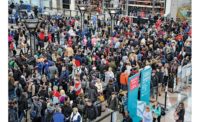The master developer team led by Continuum/East West will spearhead the $420 million redevelopment and preservation of Denver's historic Union Station.
 Continuum/East West The $420 million plan will be complete by 2011 |
The revitalization of Union Station —central hub for the Regional Transportation District's $4.7 billion FasTracks transit system build out —will be the city's largest project since construction of Denver International Airport in the early 1990s.
Wednesday's announcement was the culmination of an 18-month process that drew an initial 11 competing teams.
The Continuum/East West team—which unveiled a new name, Union Station Neighborhood Co.—will begin immediate negotiations with the four partnering agencies responsible for the project, RTD, City and County of Denver, Colorado Department of Transportation and Denver Regional Council of Governments.
"Denver Union Station will be the crown jewel of the entire FasTracks region-wide transit system," said RTD General Manager Cal Marsella. "We are pleased to have Continuum/East West on board and are eager to begin detailed negotiations this week so we can move forward with this critical project."
While members of the Union Station executive oversight committee lauded both proposals, financial feasibility and risk factors tipped the balance in favor of Union Station Neighborhood Co., whose overall cost is an estimated $75 million less than Union Station Partners' plan.
"Both teams presented compelling proposals that provide a high degree of expertise in delivering the Denver Union Station project," said CDOT Deputy Director Peggy Catlin. "Ultimately we made the best public policy and business decision for the four partnering agencies and we are excited to move forward with this visionary plan."
The Union Station Neighborhood Co. team includes Continuum Partners, East West Partners, Kiewit, DMJM Harris, Skidmore, Owings & Merrill, Kaplan Kirsch & Rockwell, PACO Group, Civil Technology Inc., DRG Construction and Ronald A. Straka Urban Design.
Highlights from its winning plan include:
- Completion of all transportation and street-level improvements by 2011, including build-out of the light rail and commuter rail facilities, as well as the integration of the regional bus system on site;
- Full under grounding of the commuter rail and regional bus components;
- Redevelopment of Union Station’s forecourt and revitalization of the existing train room simultaneous to the transit construction;
- Vertical, private development fully integrated with the public transportation components;
- Proposed 1.8 million sq ft of development over nine years, with an achievable financing plan;
- Commitment to 15 percent Small Business Enterprise participating in pre-development activities; and
- Development that complements the character of the historic neighborhood and creates significant public space and pedestrian-friendly connections.
Continuum CEO Mark Falcone said the project's biggest challenge will be integrating the transportation and vertical components. "Any major mixed-use project is complex, but layering into that this major transit infrastructure almost complicates everything by a magnitude of four," Falcone said.
Peter Park, Denver's director of planning, said successful urban design integrates many elements, including how people experience a place as they're built and as they exist.
"This proposal is an amazing proposal in how it integrates all these elements," Park said. "The plan builds on the existing strengths of the neighborhood and elevates the historic purpose of this station."
The Union Station redevelopment is part of RTD's voter-approved FasTracks program, a 12-year transit expansion program across the RTD service area that earmarks $213 million for Union Station. Other public funding for the project includes $67 million from the partnering agencies.
A $140-million Transportation Infrastructure Finance and Innovation Act loan will cover the rest of the cost. It will be repaid by tax increment financing, Metro District revenues, development rights, historic tax credits and new-market tax credits.
Diana Murphy is Editor of Colorado Construction magazine www.colorado.construction.com


Post a comment to this article
Report Abusive Comment